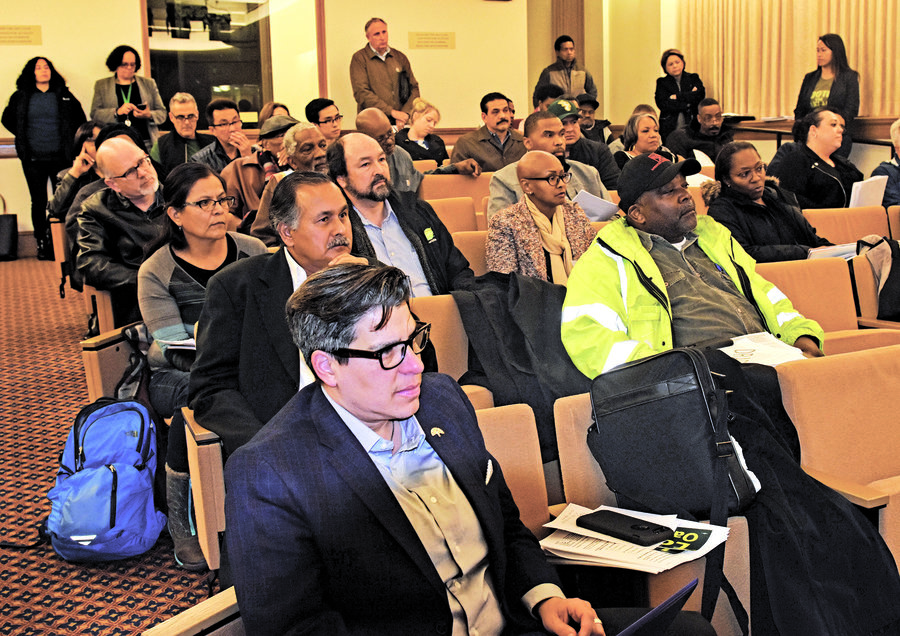City Government
Proposed City Jobs Policy Could Shut Out Black Construction Workers

City staff, along with Councilmembers Rebecca Kaplan (front left) and Abel Guillén, hosted a meeting Monday evening at City Hall to hear community feedback on proposed changes for a new labor agreement for development on city-owned lands. Photo by Ken Epstein.
City of Oakland staff held a meeting this week to discuss a proposed public lands policy, which would include a labor agreement with the Alameda County Building Trades Council that some critics fear would undermine the few jobs that exist for African-American construction workers on city-connected projects.
The proposal, as written by Councilmember Abel Guillén, would expand the coverage of the city’s current Local Employment Policy, which at present only applies to subsidized, non-market deals.
If adopted, the policy would apply to all projects involving sale or lease of city-owned land.
The Project Labor Agreement (PLA) between the city and the building trades unions would cover all projects of 80 or more housing units or with an estimated construction cost of $40 million or more.
The proposal would require the Building Trades Council to submit a report to the city within six months after the agreement is signed containing the race, ethnicity, gender and percentage of Oakland residents of each union affiliated with the labor council.
Councilmembers Guillén and Rebecca Kaplan co-sponsored the meeting.
Guillén, who chaired the discussion, explained that he has been working on the public lands policy for over a year. He said the city should strike a balance between selling property for top dollar and requiring public benefits, which would limit the amount of money the city can earn.
“Selling property gets the most money,” he said. “If we want too much, we don’t get the money. [We must] balance a public lands policy with a jobs policy.”
Under the current jobs policy, 88 percent of work on city-connected projects go to union workers, and the balance goes to nonunion or mixed nonunion and union.
Guillén said his proposal would be finalized and sent to the council for discussion and revision. He is suggesting the city pass a policy and then evaluate it after five projects in a few years “to see how we did on local hiring,” he said.
Kaplan emphasized that a new jobs policy should guarantee equity—jobs for Black construction workers and black-owned construction firms, minority workers and for women—and keep money in the local community.
“I appreciate the opportunity to participate in the jobs policy input meeting, and the thoughtful comments and suggestions made by attendees,” Kaplan said in an interview with the Oakland Post.
“I believe we can, and should, work to bring forward jobs policies for public lands that incorporate all of our community, including other issues like ‘ban the box’ as well,” she said. “We also need to continue to work to expand opportunity to get into good-paying jobs in growing construction, including apprenticeship opportunities for Oaklanders.”
Community speakers at the meeting—including representatives of small construction firms—questioned the city’s commitment to equity, based on its past track record.
“How do minority contractors in Oakland get access to contracts, especially on public land? We’re not included. We’re [always] after the fact, and it’s too late,” said Pete Varma, president of the Northern California Chapter of the National Association of Minority Contractors.
“Every time they try out something, Black contractors are left out,” said Louis Summerhill.
“How many Black contractors were involved in putting this [proposal] together?” He asked.
“This isn’t a new conversation. We are the last hired and the first fired, and it hasn’t changed,” said Eddie Dillard.
Several speakers questioned whether a new policy would make a difference if it is not enforced.
The problem with a project labor agreement, according to critics, is that contractors hire workers through hiring halls run by the building trades unions for their members, which are predominately white and have always been segregated.
As a result, African-American construction workers – no matter how experienced – tend not to be union members and have little access to union jobs. Black workers tend to work for non-union, Black-owned small construction firms.
Those job opportunities could be eliminated by a PLA.
The language of Guillén’s proposal allows non-union firms to work on city-associated projects, but “non-union contractors must make first hires from the union hall.”
The firms can then hire a “maximum of five core employees” of their firms, and after that, “All future hires are from the hiring hall.”
As a result, the PLA could mean that almost no Black workers would be able to work on city projects.
Statistics released by the city several years ago show that five percent of construction jobs on city projects went to Black workers. The Oakland Post in October requested current data from the city but has not yet received it.
According to Robyn Hodges, a member of OaklandWorks attended the meeting.
“Oakland is never going to realize equity as along as the Building Trades are writing the rules,” she said. “This plan needs to be tossed out and rewritten, the same way we did with the Army Base Project.
“This needs to become a more open process. If we keep going to the same meetings with the same people, we will be getting the same results.”
Activism
IN MEMORIAM: Nate Holden, State Senator and Longtime Los Angeles Councilmember, Dies at 95
Los Angeles County Supervisor Janice Hahn described Holden as “a lion” in the State Senate and a force to be reckoned with on the Los Angeles City Council.” Hahn added that she learned a lot working with Holden when she was a new councilmember.

By Bo Tefu, California Black Media
Former Los Angeles City Councilmember Nathaniel “Nate” Holden, a prominent figure in the city’s politics, passed away at the age of 95, his family confirmed on May 7.
Holden, who represented South Los Angeles for 16 years on the City Council and served one term in the California State Senate, was widely regarded as a forceful advocate for his community.
Los Angeles County Supervisor Janice Hahn described Holden as “a lion” in the State Senate and a force to be reckoned with on the Los Angeles City Council.”
Hahn added that she learned a lot working with Holden when she was a new councilmember.
Holden’s journey to political prominence began in the segregated South, where he was born in Macon, Georgia, in 1929. He often recalled the childhood moment when he first heard the governor of Georgia vowing to continue suppressing Black people.
“Doing the best you can for the people. Law and order. Make sure that people’s communities are safe. I did it all,” said Holden, reflecting on his legacy.
Holden is survived by his sons, including former California Assemblymember Chris Holden, who represented a district in Southern California that includes Pasadena and Altadena in Los Angeles County and cities in San Bernardino County.
Activism
Oakland Hosts Town Hall Addressing Lead Hazards in City Housing
According to the city, there are 22,000 households in need of services for lead issues, most in predominantly low-income or Black and Latino neighborhoods, but only 550 to 600 homes are addressed every year. The city is hoping to use part of the multimillion-dollar settlement to increase the number of households served each year.

By Magaly Muñoz
The City of Oakland’s Housing and Community Development Department hosted a town hall in the Fruitvale to discuss the efforts being undertaken to remove lead primarily found in housing in East and West Oakland.
In 2021, the city was awarded $14 million out of a $24 million legal settlement from a lawsuit against paint distributors for selling lead-based paint that has affected hundreds of families in Oakland and Alameda County. The funding is intended to be used for lead poisoning reduction and prevention services in paint only, not water or other sources as has been found recently in schools across the city.
The settlement can be used for developing or enhancing programs that abate lead-based paint, providing services to individuals, particularly exposed children, educating the public about hazards caused by lead paint, and covering attorney’s fees incurred in pursuing litigation.
According to the city, there are 22,000 households in need of services for lead issues, most in predominantly low-income or Black and Latino neighborhoods, but only 550 to 600 homes are addressed every year. The city is hoping to use part of the multimillion-dollar settlement to increase the number of households served each year.
Most of the homes affected were built prior to 1978, and 12,000 of these homes are considered to be at high risk for lead poisoning.
City councilmember Noel Gallo, who represents a few of the lead-affected Census tracts, said the majority of the poisoned kids and families are coming directly from neighborhoods like the Fruitvale.
“When you look at the [kids being admitted] at the children’s hospital, they’re coming from this community,” Gallo said at the town hall.
In order to eventually rid the highest impacted homes of lead poisoning, the city intends to create programs and activities such as lead-based paint inspections and assessments, full abatement designed to permanently eliminate lead-based paint, or partial abatement for repairs, painting, and specialized cleaning meant for temporary reduction of hazards.
In feedback for what the city could implement in their programming, residents in attendance of the event said they want more accessibility to resources, like blood testing, and information from officials about lead poisoning symptoms, hotlines for assistance, and updates on the reduction of lead in their communities.
Attendees also asked how they’d know where they are on the prioritization list and what would be done to address lead in the water found at several school sites in Oakland last year.
City staff said there will be a follow-up event to gather more community input for programming in August, with finalizations happening in the fall and a pilot launch in early 2026.
Alameda County
Oakland Begins Month-Long Closure on Largest Homeless Encampment
At 8 a.m. sharp, city workers began piling up trash and dismantling makeshift homes along the nearly five-block encampment. City crews blocked off streets from 14th Ave to 17th Ave, between E. 12th and International Blvd, due to the Safe Work Zone Ordinance that was passed by the city council in 2022 to protect workers from harassment during cleanings, according to a city spokesperson.

By Magaly Muñoz
The City of Oakland began a three-week-long breakdown of the largest homeless encampment in the city on E. 12th Street on Monday morning. Residents and advocates said they are devastated about the displacement of dozens of people.
At 8 a.m. sharp, city workers began piling up trash and dismantling makeshift homes along the nearly five-block encampment. City crews blocked off streets from 14th Ave to 17th Ave, between E. 12th and International Blvd, due to the Safe Work Zone Ordinance that was passed by the city council in 2022 to protect workers from harassment during cleanings, according to a city spokesperson.
Jaz Colibri, one of the many advocates at the closure, said the encampment sweeps were “intense and terrifying” to witness. They claimed that several residents, many of them non-English speakers, had not been aware that the sweep was happening that day because of a lack of proper communication and outreach from Oakland.
Colibri added that the city had done a Census “many months ago” and “had not bothered to count people since then”, meaning dozens of individuals have missed out on housing and resources in the last few weeks because the city doesn’t offer outreach in multiple languages.
“Basically, [Oakland] dropped the ball on actually getting to know everybody who lives here and then creating a housing solution that meets everyone’s needs,” Colibri said.
City spokesperson Jean Walsh told the Post that notices of the closure operation were posted in Spanish and Chinese prior to Monday, but did not clarify if outreach was done in those languages as well.
Nearly a dozen Oakland police vehicles, California Highway Patrol officers, and Oakland Public Works staff were gathered along E 12th waiting for residents to pack up their belongings and move away from the area.
Advocates said residents “felt unsafe” due to the hefty law enforcement presence.
One city worker, who was picking up debris near 16th Ave, said, “They’ve known we were coming for a long time now” in reference to resident confusion about the sweeping.
The state doubled down on its requirement to get cities and counties to deal with their homelessness crisis at a press conference Monday afternoon. Gov. Gavin Newsom’s office released a “model ordinance” that is intended to provide a starting point that local municipalities can use to build from and adjust in creating their own policies on encampments, if they haven’t done so yet.
Newsom said “No more excuses, time to deliver” after the state has poured hundreds of millions of dollars into solving the issue.
Oakland was awarded a $7.2 million grant from the state in 2024 to close long-standing encampments in the city, including camps at Martin Luther King, Jr. and 23rd Street, and Mosswood Park.
Residents at these encampments were offered wraparound supportive services, temporary shelter, and eventually will be transitioned to permanent supportive housing, according to a city statement from last year.
Residents who accepted housing at these three encampments were moved into newly acquired property, formerly the Extended Stay America Hotel in West Oakland, which will first serve as interim housing for up to 150 individuals and couples in 105 units, and in the coming year, will be converted into 125 units of permanent housing.
Walsh said as of May 2, “32 residents of the recently closed Mosswood Park encampment moved into the Mandela House program” and as of May 12, “41 residents of the East 12th Street encampment have already accepted offers to move to the Mandela House.” The city will provide final numbers of how many accepted and moved into housing after the closure operation is over.
-

 Activism4 weeks ago
Activism4 weeks agoAI Is Reshaping Black Healthcare: Promise, Peril, and the Push for Improved Results in California
-

 Activism4 weeks ago
Activism4 weeks agoBarbara Lee Accepts Victory With “Responsibility, Humility and Love”
-

 Activism4 weeks ago
Activism4 weeks agoESSAY: Technology and Medicine, a Primary Care Point of View
-

 Activism4 weeks ago
Activism4 weeks agoFaces Around the Bay: Author Karen Lewis Took the ‘Detour to Straight Street’
-

 Activism4 weeks ago
Activism4 weeks agoNewsom Fights Back as AmeriCorps Shutdown Threatens Vital Services in Black Communities
-

 Arts and Culture4 weeks ago
Arts and Culture4 weeks agoBOOK REVIEW: Love, Rita: An American Story of Sisterhood, Joy, Loss, and Legacy
-

 #NNPA BlackPress4 weeks ago
#NNPA BlackPress4 weeks agoThe RESISTANCE – FREEDOM NOW
-

 Alameda County4 weeks ago
Alameda County4 weeks agoOUSD Supt. Chief Kyla Johnson-Trammell to Step Down on July 1












































